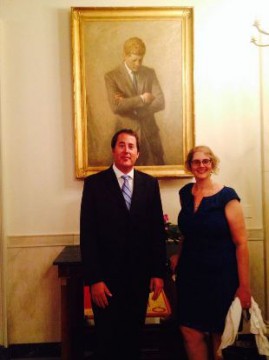Receivin g an email a few weeks ago from someone who claimed to be writing from the White House, Napa nonprofit executive Terence Mulligan admitted that at first “I thought it was spam and ignored it.”
g an email a few weeks ago from someone who claimed to be writing from the White House, Napa nonprofit executive Terence Mulligan admitted that at first “I thought it was spam and ignored it.”
It was only after the real White House called that Mulligan finally realized the invitation was, indeed, the real thing.
Mulligan is president of the Napa Valley Community Foundation (NVCF). He and his team were invited to the White House this past week because of the Foundation’s work on a project called the One Napa Valley Initiative. The program helps local residents become U.S. citizens.
“I was surprised that our citizenship work was on their radar,” said Mulligan. “I’m so pleased, and proud” to be invited to the White House and talk about the One Napa Valley Initiative.
On Tuesday, Mulligan and the foundation’s vice president, Marla Tofle, met with a group of about 15 key foundation and philanthropic leaders from across the U.S. at the White House. They discussed the recently released Task Force on New Americans report to the president and a national public awareness campaign to promote citizenship.
“I’m proud to see Napa Valley Community Foundation recognized by the president for their program that helps people become citizens,” U.S. Rep. Mike Thompson said in a news release.
Following that two-hour meeting, NVCF staff and two other Napans celebrated Cinco de Mayo at a White House ceremony with the president.
“I got to meet Mr. Obama, shake his hand and take a picture with him, which was awesome,” Mulligan said.
Victor Cruz, a Napa resident who recently became a U.S. citizen through the Foundation’s One Napa Valley Initiative, attended the Cinco de Mayo celebration, along with Melissa Patrino, the executive director of Puertas Abiertas Community Resource Center, one of the Foundation’s nonprofit partners for the citizenship program.
Cruz, a classroom behavioral aide at Silverado Middle School, became a citizen in December 2013.
Being invited to the White House “was just incredible,” he said. “I couldn’t help thinking, ‘Is this real?’ It was such an honor to be there. Celebrating Cinco de Mayo with my community and seeing Obama was just too surreal.”
Cruz said he got to shake the president’s hand in passing. Up close, “he looks a lot thinner” than on TV, he said.
“His hands were really soft, and he had a nice smile and made eye contact with everyone.”
Since the Foundation’s citizenship project began in the summer of 2013, the nonprofit said:
— more than 25,000 residents have been reached with information about the benefits and requirements of citizenship;
— nearly 1,000 clients have received legal consultations or participated in new English as a second language classes, a number that represents more than 10 percent of the county’s population of legal permanent residents, or green card holders;
— 348 people have submitted applications to become citizens;
— 216 people have actually become U.S. citizens.
The One Napa Valley Initiative was started on the heels of a 2012 study on the economic and fiscal impact of immigration in Napa County, which was funded by NVCF and conducted by a nonpartisan think tank in Washington, D.C.
That study, the first of its kind for the region, underscored the substantial economic contributions made by immigrants in Napa Valley, and pointed to a significant citizenship gap: many immigrants in Napa County are eligible to become citizens, but they haven’t done so nearly as frequently as their peers around the state, officials said.
“Only 30 percent of Napa County’s foreign-born population have become citizens versus 37 percent in California overall,” said Mulligan, noting that the scarcity of legally based immigration services in Napa County helped explain the gap.
“There are nearly 9,000 citizenship-eligible legal permanent residents in Napa County. When they naturalize, good things happen for their families, and good things happen for the community at large,” he said.
Citizenship is correlated with higher family income, higher educational attainment for the children of immigrants that naturalize, higher proficiency in English, and more active engagement in community affairs, Mulligan said, adding that growth in family income can also be a big boost to the local economy.
Through the foundation, 129 local donors invested $1.1 million to make the three-year citizenship campaign a reality. The donors include individuals, businesses, foundations, Napa County’s Health and Human Services Department, and all five municipal governments in the county.
Mulligan said he hoped the trip to Washington will raise awareness for the project, because the Foundation seeks additional donations to extend the program for another three to five years.
“We got involved because the Community Foundation has a smart plan in place that’s going to help the whole community,” said Michael Mondavi, a donor. “We would encourage others to make a contribution to this effort, as well.”
“Immigrants are an important part of Napa Valley’s history, culture and economy, and supporting them to obtain citizenship is beneficial for our entire Valley — for immigrants and non-immigrants alike,” said Thompson. “Many thanks to them for their great work on behalf of our community.”